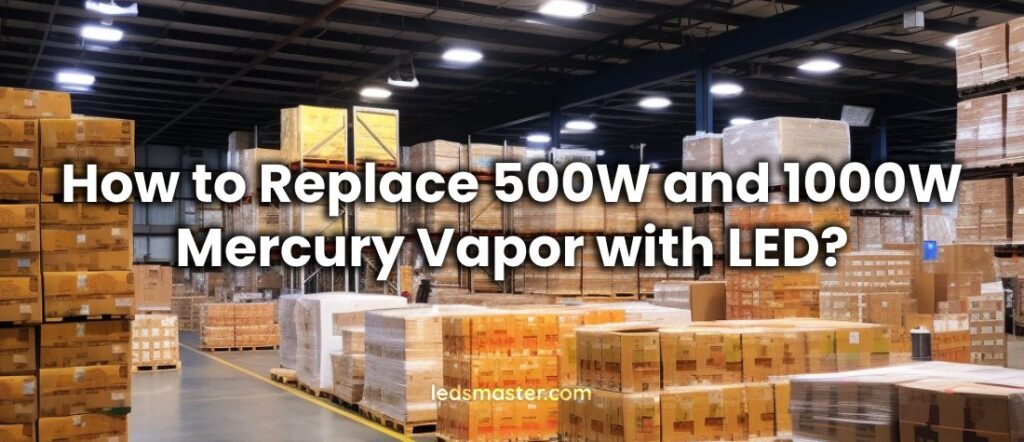The trend of replacing mercury vapor and high-pressure sodium lights with LEDs is becoming increasingly prevalent. This shift is visible across a wide range of venues including football fields, baseball stadiums, tennis courts, parking lots, basketball courts, airport hangars, warehouses, seaports, and other commercial areas. These locations are opting for LED lamps to retrofit traditional HID (High-Intensity Discharge) lighting due to the significant benefits LEDs offer.
Upgrading from 1000-watt or 500-watt mercury vapor lamps to LEDs provides several immediate advantages, including improved energy efficiency and reduced operational costs. Specifically, a 125-watt LED lamp can effectively replace a 500-watt mercury vapor lamp, while a 250-watt LED lamp is suitable for replacing a 1000-watt mercury vapor or high-pressure sodium lamp. This transition results in energy savings of at least 80%, making it a cost-effective and environmentally friendly choice for lighting in large commercial and recreational spaces.
Table of Contents
ToggleWhat is Mercury Vapor and High-Pressure Sodium Retrofit?
Retrofitting refers to the process of upgrading existing lighting systems by directly replacing older lamps, such as mercury vapor, halogen, or high-pressure sodium, with more efficient LED alternatives. This process involves removing the old lamp and simply screwing an LED bulb into the same fixture. By using LEDs, we significantly reduce installation time and costs compared to a full replacement of the lighting system.
The key aspect of a successful retrofit is selecting the appropriate wattage of LED lamps to match the original high-intensity discharge (HID) lamps. Choosing the correct LED wattage ensures that the new lights provide equivalent or better illumination while consuming less energy. For instance, a 125-watt LED can replace a 500-watt mercury vapor lamp, and a 250-watt LED can substitute for a 1000-watt mercury vapor or high-pressure sodium lamp. This careful selection allows for effective lighting that meets the original requirements while delivering substantial energy savings and enhanced performance.

How to Replace 1000-Watt Mercury Vapor or Halogen Lights with LED?
When upgrading from a 1000-watt mercury vapor or halogen lamp to an LED equivalent, the key factor to consider is the lumens—the measure of brightness—produced by the original lamp and finding an LED lamp that provides the same lumens. This ensures that the new lighting maintains the necessary illumination levels while benefiting from improved efficiency.
Here’s a step-by-step guide to effectively replacing 1000-watt mercury vapor or halogen lamps with LEDs.
1. Determine the Lumen Output of the Existing Lamp
A typical 1000-watt mercury vapor lamp emits around 40,000 lumens, calculated by multiplying the wattage by the lamp’s lumen efficacy (approximately 40 lumens per watt for mercury vapor).
2. Calculate the Required LED Wattage
To replace this 1000-watt mercury vapor lamp, you need an LED lamp that provides the same total lumen output. LED technology is much more efficient, typically offering around 160 lumens per watt. Therefore, to match the 40,000 lumens output, divide 40,000 lumens by 160 lumens per watt, resulting in a requirement of a 250-watt LED lamp.
3. Select the Appropriate LED Lamp
Choose an LED lamp with the calculated wattage. For a 1000-watt mercury vapor lamp replacement, a 250-watt LED lamp will deliver comparable brightness while using significantly less power, achieving around 75% energy savings.
4. Ensure Compatibility and Installation
Verify that the selected LED lamp is compatible with the existing fixture. Some fixtures might require minor modifications such as ballast removal or bypass. The actual installation involves simply removing the old lamp and screwing in the new LED lamp, making it a straightforward process.
5. Test and Optimize
After installation, test the new LED lamp to ensure it provides the expected lighting levels. Make any necessary adjustments to the fixture or placement to optimize the lighting output.
6. Enjoy Cost Savings
The switch to LEDs not only enhances energy efficiency but also leads to substantial cost savings. For example, if the original mercury vapor lamp’s electricity cost is $1000, the equivalent LED system would reduce this cost to approximately $250 due to its lower power consumption.
Example of LED Replacement Benefits
| Original Lamp | 1000W Mercury Vapor (40 lumens/watt) |
| Lumens Output | 1000W x 40 = 40,000 lumens |
| Required LED Lamp | 250W LED (160 lumens/watt) |
| Energy Savings | Approximately 75% |
| Cost Reduction | From $1000 to $250 |

How to Replace 500-Watt Mercury Vapor Lights: Understanding the Power Equivalent
Replacing a 500-watt mercury vapor or high-pressure sodium lamp with LED lighting involves calculating the appropriate LED wattage to achieve equivalent brightness. This ensures that the new lighting system provides similar or improved illumination while offering significant energy savings. Here’s a detailed guide on how to perform this replacement effectively.
1. Calculate the Lumens of the Existing Lamp
A 500-watt mercury vapor lamp typically produces around 20,000 lumens. This is based on a lumen efficacy of about 40 lumens per watt for mercury vapor lamps (500W x 40 lumens per watt = 20,000 lumens).
2. Determine the Required LED Wattage
To achieve the same brightness with LED lighting, you need to match the total lumen output of the existing lamp. LEDs are much more efficient, with an efficacy of approximately 160 lumens per watt. To calculate the needed wattage for an LED, divide the total lumens by the lumens per watt of the LED:
Required LED Wattage = 20,000 lumens / 160 lumens per watt = 125 watts
Therefore, a 125-watt LED lamp can replace a 500-watt mercury vapor or high-pressure sodium lamp, providing the same level of illumination.
3. Consider Your Lighting Needs
While matching the lumen output ensures equivalent brightness, you might want a brighter environment. In such cases, you can choose a slightly higher wattage LED. For instance, using a 150-watt or even a 200-watt LED lamp will provide increased illumination compared to the original 500-watt mercury vapor lamp.
4. Ensure Compatibility and Installation
Ensure compatibility by verifying that the new LED lamp matches the existing fixtures. In some cases, retrofitting may necessitate removing or bypassing ballasts within the fixture to accommodate the LED’s operational requirements. Installation is typically straightforward: remove the old lamp and seamlessly install the new LED lamp in its designated position. This streamlined process minimizes installation complexity and ensures a smooth transition to energy-efficient LED lighting.
Example of LED Replacement
| Original Lamp | 500W Mercury Vapor |
| Lumens Output | 500W x 40 lumens/watt = 20,000 lumens |
| Required LED | 125W LED (160 lumens/watt) |
| Energy Savings | Using a 125W LED results in significant energy savings over the 500W mercury vapor lamp. |
Flexible Lighting Options
| For 500W Replacement | Consider a 150W or 200W LED lamp. |
| For 1000W Replacement | Opt for a 300W to 400W LED lamp. |
These adjustments can make the area significantly brighter, enhancing visibility and functionality.
What Are the Advantages of Replacing Mercury Vapor and High-Pressure Sodium with LED?
Replacing traditional mercury vapor and high-pressure sodium lamps with LED lighting offers numerous advantages beyond simple energy savings. This transition brings benefits in terms of longevity, safety, control, and overall maintenance costs, making LEDs a superior choice for various applications, including sports fields, commercial areas, and industrial environments. Below are the key advantages of this upgrade:
Significantly Longer Lifespan
One of the most compelling advantages of LEDs over mercury vapor and high-pressure sodium lamps is their remarkably longer lifespan. LED lamps can last up to 150,000 hours, translating to approximately 30 years of use under typical conditions. In contrast, mercury vapor lamps generally offer a lifespan of about 10,000 hours. This shorter lifespan necessitates frequent replacements, leading to higher costs not only for the lamps themselves but also for the labor required to install them. By switching to LEDs, the need for frequent replacements is virtually eliminated, drastically reducing maintenance costs over time and ensuring more consistent and reliable lighting performance.
Enhanced Energy Efficiency
LEDs are substantially more energy-efficient compared to traditional mercury vapor and high-pressure sodium lamps. For instance, a 125-watt LED can effectively replace a 500-watt mercury vapor lamp while delivering the same level of brightness. This efficiency can result in energy savings of around 75%. The reduction in power consumption directly translates to lower electricity bills, offering significant cost savings. For example, replacing a 500-watt mercury vapor lamp with a 125-watt LED could reduce annual operational costs from $1000 to approximately $250. This not only benefits the environment by lowering energy use but also provides immediate financial benefits.
UV-Free Light Emission
A critical safety improvement offered by LEDs is the absence of ultraviolet (UV) radiation. Mercury vapor and high-pressure sodium lamps can emit harmful UV rays, especially when the lamps are damaged or reach the end of their lifecycle. This UV emission can pose health risks, including skin burns and eye damage, and can deteriorate materials over time. LEDs, on the other hand, are solid-state devices that emit light solely within the visible spectrum. This elimination of UV radiation enhances safety for both users and equipment, making LED lighting a more health-conscious choice for various environments.
Precise Lighting Control
Replacing traditional HID lamps with LEDs allows for far more precise control over lighting. LEDs offer up to ten times better optical control compared to mercury vapor and high-pressure sodium lamps. Technologies such as LM75 optics enable precise focusing and direction of light beams, which significantly reduces spill light and light pollution. This is particularly beneficial for outdoor settings like sports fields and parking lots, where controlling the direction and distribution of light can enhance visibility and safety. Moreover, LEDs improve light uniformity and reduce glare, creating a more comfortable and efficient lighting environment.
Independent LED Driver
Modern LED systems often feature an independent driver (power supply) that can be positioned separately from the lamp body. This design reduces the weight attached to the light pole, which enhances safety and convenience, particularly in large installations such as sports fields where multiple lights might need replacement. The separation of the driver and lamp body simplifies maintenance and allows for easier access to components, reducing the need for heavy-duty support structures and making the system more adaptable to various installation requirements.
Enhanced Environmental Impact
Switching to LEDs also has a positive environmental impact. Unlike mercury vapor lamps, LEDs do not contain mercury or other hazardous materials, which helps reduce the risk of environmental contamination and simplifies disposal. The significant energy savings provided by LEDs also contribute to a lower carbon footprint, supporting broader sustainability goals. This makes LEDs a more environmentally friendly option, aligning with efforts to reduce energy consumption and minimize waste.
Superior Performance in Harsh Conditions
LEDs are known for their durability and reliability, especially in harsh environmental conditions. They perform well in extreme temperatures and do not require additional warming time, unlike traditional lamps that may struggle in cold weather. The solid-state nature of LEDs makes them more resistant to vibrations and impacts, ensuring consistent performance in various demanding applications such as industrial settings and outdoor installations. This reliability contributes to a lower likelihood of lighting failures and enhances overall operational efficiency.
Free Lighting Consultation and Design Services
LedsMaster offers free lighting consultation and design services to help you choose the most suitable LED lamps for retrofitting HID lamps, including mercury vapor and high-pressure sodium lamps. Our expert team provides personalized recommendations to ensure optimal lighting performance and energy efficiency. If you need assistance with selecting the right LED lamps for your project, please don’t hesitate to contact us for a complimentary consultation.
By following these guidelines, you can successfully replace your 1000-watt mercury vapor or halogen lights with efficient and cost-effective LED lighting, enhancing both the quality and sustainability of your illumination systems.
Conclusion
Switching from mercury vapor and high-pressure sodium lights to LED lighting is becoming increasingly popular in various commercial and recreational settings, including sports fields, parking lots, and warehouses. This upgrade offers several immediate benefits: a 125-watt LED can replace a 500-watt mercury vapor lamp, and a 250-watt LED can substitute for a 1000-watt mercury vapor or high-pressure sodium lamp, resulting in at least 80% energy savings.
Retrofitting to LEDs involves simply replacing the old lamps with LED bulbs of appropriate wattage, providing equivalent or superior illumination while significantly reducing energy consumption and operational costs. LEDs offer longer lifespan, improved efficiency, and precise lighting control, making them a cost-effective and environmentally friendly choice for modern lighting needs.

